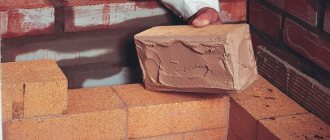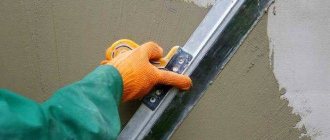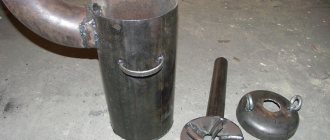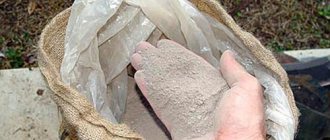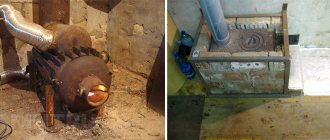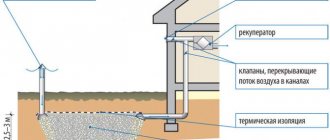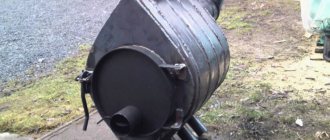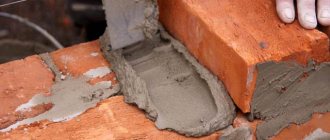Sometimes it is not possible to find a truly professional stove maker. In this matter, it is necessary to take into account many nuances, and any deviation from technical standards can lead to irreparable consequences, which will undoubtedly affect the quality of the structure itself during its operation.
One of the most important points is the selection of masonry mixture. That is why many craftsmen are interested in what composition of mortar with fireclay for laying a stove would be more correct to use. After all, it directly determines whether the structure will be strong and durable.
Ready-made composition for masonry
Advantageous properties of clay
Fireclay has some advantages over other materials due to the following characteristics:
- Long service life. Fireclay clay mortar does not crack, does not crumble, and retains its original shape for a long time.
- High adhesive properties, thanks to which the material adheres perfectly to any surface.
- Vapor permeability.
- Ability to withstand fairly high heat.
- Safety and environmental compliance.
Clay selection
When choosing refractory clay, you should pay attention to the packaging labeling. It has a special digital combination showing the fire resistance of the material. You should know that large values indicate high fire resistance of the clay. In addition, by the markings you can find out about the area of use of the material and for laying which bricks clay of this type is used.
The shelf life of chamotte clay is of great importance, since after a certain time kaolin loses its technical properties. Therefore, you should not purchase material after the end of the sales period.
Specifications
When considering the technical characteristics of fireclay clay for oven plaster, it is necessary to note the following:
- The grain size corresponds to two millimeters.
- Highly fired fireclay absorbs no more than 10% moisture, and low fired fireclay absorbs no more than 25% moisture.
- The maximum temperature that the material can withstand is 18500C.
- The humidity of quality material does not exceed 5%.
When determining the required amount of material, you should know:
- A standard 20 kg package of clay is enough to lay 30 bricks.
- For 1 m3 of masonry, you should purchase 100 clay.
- A solution prepared with precise adherence to technology becomes absolutely solid after 24 hours, provided that the air temperature does not fall below +100C.
Clay in industrial packaging can be stored for 3 years from the date of manufacture.
Features of refractory clay
The preparation of mortar from fireclay clay for laying stoves is carried out by analogy with plaster mixtures, the application methods are also similar, which gives a big advantage to the material.
Fireclay mixture is suitable for sculptural work and decoration, for the construction of stoves and fireplaces. Products become durable due to the evaporation of moisture during the drying process of the clay composition. The result is a high-strength material that is resistant to high temperatures.
The following features of fireclay include:
- It does not crumble under high temperature.
- The material is resistant to the external environment.
- The original form remains unchanged for a long time.
To work with clay, you do not need to purchase special tools; the work process is carried out using a long and short spatula. Use one tool to lay the solution, and use another spatula to remove smudges.
What it is
Fireclay is a fire-resistant substance obtained from kaolin. The clay is heated to 1.3-1.5 thousand degrees, as a result of which the mass loses moisture and plasticity. During the process, the material sinteres and changes color from gray to brown. The burned pieces are crushed with special metal shafts to the state of fine sand of different fractions.
As a result of temperature changes, clay characteristics are radically transformed. The result is a very strong raw material, with parameters resembling stone. Due to the loss of liquid, the material does not expand when heated, maintaining its strength. After drying, the finished mixture does not shrink or crack.
Fireproof material Source remokna.in.ua
Fireproof fireclay is a semi-finished product for preparing mortar. By adding certain additives it is easy to adjust the parameters and adjust the mass to the needs of a person. You can find out the material in the store by the letter “Ш” on the packaging. The abbreviation “MSh” or “MP” is present in the names of the ready-to-use composition (mortar). The letter “U” is on a pack of a less strong recycled substance (after secondary processing).
Kaolin clay is classified as a material of natural origin. Raw materials are mined from the bottom of seas, lakes or rivers. The appearance and constituent substances often depend on the location of the deposits. The most common is light gray raw material, there are shades of pink, yellow and blue.
Where are raw materials mined Source teplo.guru
Clay preparation steps
It is very important for home craftsmen to know how to prepare fireclay clay for laying stoves. To do this, you can use the following scheme:
- Take a package of powder and pour it into a previously prepared container.
- Pour the powder with water and leave to swell for three days.
- After this time, water is added again and the clay is mixed at the same time. The process is continued until a homogeneous mass is obtained.
- In some cases, sand may be added.
When working with clay, it is necessary to constantly stir the solution; the quality of the work depends on this. In addition, it is important to pay attention to the consistency of the solution; it is recommended to add water to a too thick composition, and powder to a liquid one. It is especially important to fulfill this condition when laying a furnace using refractory clay.
The amount of water in the solution plays an important role: the dry composition crumbles and crumbles, the liquid composition flows down the working surface. Therefore, it is very important to know how to dilute fireclay clay for laying stoves. When calculating the water used, it should be taken into account that a solution of normal consistency resembles thick sour cream.
If clay is used in the process for instant work, then you need to pay attention to its features. When preparing the solution, you do not need to leave the powder to swell for three days, so the whole process will take much less time.
Checking the consistency of the solution
To check the correctness of the kneading, you need to dip a clean trowel soaked in water into it:
- If the solution sticks to the surface of the tool, it means that the clay is too oily, and a small amount of sand must be added to the mixture.
- When the mixture does not stick to the tool, the fat content is normal, but the plasticity is not enough. This indicator can be increased by adding clay with high fat content.
- The presence of protruding water in the solution after settling is evidence of the mixture being too lean. The composition can be corrected by reducing the sand component by introducing fatty or ordinary clay.
Each time you change the mixture, you need to lower the tool again until the ideal consistency is achieved.
Laying stoves and fireplaces
Stoves and fireplaces are structures that are constantly exposed to intense heat, so it is very important to choose the appropriate material. Firebricks made from fireclay clay are ideal for this purpose. When buying bricks of this type, you should pay attention to the marking, which should contain the letter “W”. However, fireclay brick is expensive, so it is purchased for laying out the firebox, and ordinary brick is used for the construction of the main structure.
It is very important to remember that fire bricks are only laid on a fire clay mortar. In this case, the expansion coefficient of the mortar and brick should be the same.
Plastering process
A solution of refractory clay is used in cases where it is necessary to obtain a perfectly flat surface. In the process of work, corners and a special profile are necessarily used. Several profiles installed on one wall help to achieve absolutely even plaster. During the installation process, it is recommended to use a plumb line or building level. Corners are used to obtain smooth edges; they are glued directly to the plane.
To obtain a perfectly flat surface, you should use the rule. It is fixed across the vertical profiles so as to achieve simultaneous contact of all beacons horizontally.
When installing beacons, you should also pay attention to the level of extension of the furnace door and the blower. The level of the profiles and doors must match so that the surface is smooth, without protrusions and depressions.
To make working with refractory clay mortar easier, you can use a special leveling tool. In this case, you can easily get a flat plane, but with small cracks. This problem can be solved using an ordinary wide spatula, which can be used to smooth the entire surface.
Methods for removing impurities
From the natural clay stored for oven laying, the first step is to remove foreign impurities. Various methods are used for this.
Dry punching
You can rub the clay through a sieve dry or soaked.
The most primitive way. Use your hands to pick out everything unnecessary - grass, pebbles, garbage, crush large clods. After this, the plastic material must be ground through a metal sieve with cells of approximately 3 mm.
The method can be made a little less labor intensive if the clay is dried. To do this, clay lumps are laid out on a wooden sheet and dried in the sun. In winter, this is done in the cold, laying it under a canopy so as not to be covered with snow. If the volume of material is small, it is placed indoors, on a heated stove or on a heating radiator. The drying speed depends on the size of the lumps: the smaller they are, the faster they dry.
Pour the dried clay into a box with thick walls and crush it with a tamper. After grinding, clay dust is sifted through a sieve with small mesh to remove various inclusions from it: pebbles, splinters, and other debris.
“Dry punching” is a rather labor-intensive task, so it is more advisable to soak the clay for 2-3 days after manual cleaning.
- Place the material in a large basin in layers of 12–15 cm, with plenty of wetting.
- Pour water in an approximate ratio of one to four with clay.
- When the mass softens, mix with a concrete mixer or other means.
- Wipe through a grid with 2–2.5 mm mesh.
The bottom layer - sand and stones - is not suitable for holding bricks together
There is also a more ancient method of excruciation:
- Several holes are drilled vertically in a wooden container with a small distance between them.
- Each of them, before filling the tub with liquid clay mass, is plugged with a wooden stopper.
- Grains of sand and various small stones precipitate first due to their greater weight.
- Subsequently, after settling, clay particles settle to the bottom.
- The top layer of water gradually becomes lighter, but you need to wait until the liquid becomes transparent. As soon as the boundary of the clarified moisture drops slightly below the first hole from above, the plug is removed. The settled water flows out of the container.
- After the next level of settled liquid appears, pull out the next plug.
This process is repeated until all clarified water is completely drained. To speed up the precipitation, after loading the solution into the tub, you will need to add bitter Epsom salt - approximately one pinch per bucket. If you don’t have a wooden barrel at hand, it can be successfully replaced by a metal container of suitable height and volume. The principle of operation is the same with one difference - first short pieces of tubes are soldered into the holes, and plugs are installed in them.
When all the settled liquid has been drained, the liquid clay is transferred to a wide box and left in the sun to evaporate excess moisture. After the dried material ceases to be fluid, stir it periodically with a shovel. As soon as the mass becomes similar in texture to thick dough and stops sticking to the palms, it is covered with polyethylene or oilcloth and stored until baking begins.
Additional uses of fireclay clay
Very often, refractory clay is used to make decorative elements. These can be tiles, figurines and even household dishes. The plasticity of such clay is given by special components added to the composition.
Fireclay clay can be used to prepare high-quality mortar for laying stoves and plastering various surfaces. When deciding how to plaster a stove with fireclay clay, strict adherence to all technologies allows you to independently complete the entire process from preparing the solution to applying it to the surface.
Mineral composition
The raw material for the production of fireclay is clay, consisting of highly dispersed hydroaluminosilicates. In addition to them, the dry mass contains a certain amount of impurities. The extracted raw materials undergo a roasting procedure, after which they are enriched with minerals. There are many recipes that differ in the amount of water, fireclay powder and additives. The duration of heat treatment also varies. It depends on what characteristics the output product should have . The main difference is the colors and types of texture.
Chemical elements in refractory clay:
- Fe2O3;
- K2O;
- Al2O3;
- Si02;
- Na2O;
- CaO;
- MgO.
